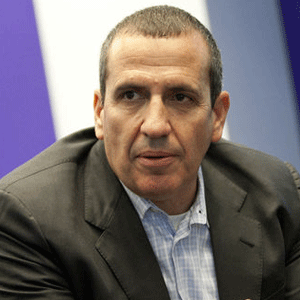THANK YOU FOR SUBSCRIBING

Bask Iyer, CIO, White Case
In today’s rapidly changing business world, the old “if it ain’t broke, don’t fix it” attitude no longer suffices when it comes to IT. In fact, we should consider a new approach: “If it ain’t broke yet, why not? Let’s break it!”
"My mental picture of a good change agent is someone who has a few arrows in her back, but still has a smile on her face"
Although I’m exaggerating to make a point, I think that no action is riskier than inaction. Driving innovative change is the only way to stay afloat, let alone compete. But this can be difficult to do. Why? Because IT is the nerve center of any modern enterprise, and operational efficiency and risk mitigation are top-of-mind items for every CIO and company board member. This mindset often paralyses the IT function, which becomes geared toward playing defense and maintaining the status quo. There are, of course, clear connections between IT, employee satisfaction, brand reputation, and a company’s bottom line.
But to successfully move the company forward, today’s CIO has to play more than a robust defense: He or she has to become an advocate for a culture of IT evolution, willing to spearhead big risks, continually, when no one else can perceive the business value of doing so. The CIO has to actively strive to lead a company-wide process of IT experimentation and iteration. Change is inevitable and today’s proactive IT leader has to become, in effect, what I call a Change Management CIO.
And, there are a few general ways to both advance and succeed in that direction. Let me share my experience and what has worked for me.
Ride the Current Wave
I live in California, and love spending time at nearby beaches observing surfers. Some surfers ride any wave that comes their way, while others just keep waiting for the “right” wave. The second type of surfer not only tends to miss the present waves but also typically misses the supposedly right wave when it finally arrives.
The world of IT has its own waves. And just like those surfers, some CIOs tend to wait for the so-called next big thing, instead of riding the current waves that are here right now.
Today, the two biggest waves are cloud and mobile. A lot of us pretend to be on top of both situations and can talk a good game, but very few of us are riding these waves as well as we can. First, there are often too many hurdles that inhibit the rapid adoption of cloud or mobile solutions, including the complexity of legacy infrastructures and the imagined high costs of a cloud migration.
Innovations in both of these areas can radically alter an IT landscape, and waves this big don’t come along often. Don’t ignore their potential.
Be Plugged In
Next, as a CIO you need to make sure that all of the decision makers in the company are on the same page when it comes to introducing new ideas, which starts by cultivating trust and credibility. If you don’t have credibility, your big ideas won’t get the traction they deserve. Even if the CEO is on your side, the rest of the leadership team might have a different agenda, so it pays to invest early on in earning your colleagues’ respect by exceeding expectations.
Technology is changing dramatically, so you also need to be plugged into current trends. But just reading magazines won’t do. You’ve got to be aware, paying attention to everything going on in your industry. Conduct research among your customers, go out and meet other practitioners, and stay in touch with your sales and marketing departments in case current and potential customers offer feedback on the solutions you provide.
Say No to More Operational Tasks
Overseeing operations is an important part of being CIO, but if you’re always buried in ops, then someone else, with less power to execute, will likely end up taking the lead on any potential innova-tion. That’s why it is important to appropriately delegate many operational responsibilities, and it’s not always easy. I’m sometimes guilty of this myself.
Moreover, since most CIOs are great at operations, they are often asked to take on more back-office functions. As they say, no good deed goes unpunished. I have done my share of running factories, shared services, real estate, restructuring, payroll, etc. But this only further typecast me as a solid operator, and did not give me the opportunities I needed to pursue more innovative or front-office functions.
However, as an IT manager, you can’t ever completely separate yourself from operations. If you do, your credibility as a CIO almost immediately disappears. Let’s say you come to me and ask me about a problem with the network, and I tell you that I don’t engage in such daily minutiae anymore. You’ll listen to me out of courtesy, but you’ll still want to talk to the guy who actu-ally manages the network. I’d lose credibility as a leader, especially if I don’t seem to know what’s going on at any given time.
So as CIO you have to strike the right balance, getting your hands dirty while still freeing up some of your time to do more important things, like talking to actual customers, finding out what problems they may be having, what they want to achieve next, and how their business model might be improved with your products and services. To be an effective Change Management CIO, you have to learn to wear two hats: those of an idealistic visionary and a pragmatic manager, which, day to day, requires a delicate balancing act.
Make it Work—It’s Never Easy
Company culture has to be encourage risk taking and innovation. I have seen great change agents struggle in some companies and sometimes even settle and compromise to fit into the culture of the company. And in some companies even an average worker is encouraged to drive change and make a difference and they do! Some times in your career, you are fortunate to work for progressive company that encourages risk taking and innovation. There are times that you may be not that fortunate.
In such cases, my general advice is simple: Try harder to make it work. As a business leader, you have an obligation to create a culture and environment that enables innovation and empowers risk-takers. Build coalitions, network, encourage, and persuade. But if even that doesn’t eventually work, move on. You’ll know you did your best.
Remember that change management is inherently challenging, no matter where you go. The risks are always high, and you’ll be criticized and discouraged. My mental picture of a good change agent is someone who has a few arrows in her back, but still has a smile on her face.
Weekly Brief
I agree We use cookies on this website to enhance your user experience. By clicking any link on this page you are giving your consent for us to set cookies. More info
Read Also
Artificial Intelligence - Myths And Truths
Sustainable Future through Innovative Technology Solutions
The Future Relies on Augmented AI
Digitalization with the use of digital technologies/Improving business through digital technologies
How Marco's Pizza Leaned On Technology To Succeed Amid The Pandemic By Quickly Pivoting To Contact-Free Delivery And Curbside Carryout
Bunnings Diy Digital Transformation
For a Smarter City: Trust the Data, Ignore the Hype
Smart Community Innovation for the Post Pandemic





















